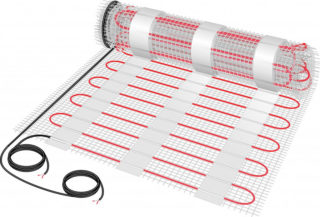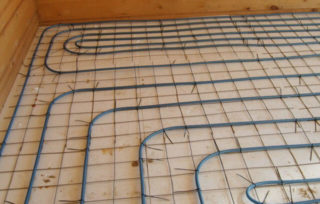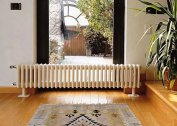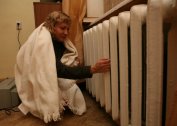Tile flooring is done in rooms with high humidity and high traffic. Usually, this option of facing is chosen for the kitchen, bathroom, corridor and balcony. In summer, walking on such a surface is pleasant and comfortable. However, in the cold season, the base becomes cold, and fabric flooring is not the best aesthetic solution. Laying a warm floor under the tile is the best way out of this situation both for a private house and for an apartment in a high-rise. Even an inexperienced master can do this job. The main thing is to choose the right material and observe the technology of its installation.
Pros and cons of underfloor heating under the tile
The installation of heating elements under the tile, like any technical solution, has its pros and cons. They must be considered before making a responsible choice in favor of their installation.
The underfloor heating under the tile gives the following advantages:
- Uniform heating of the surface. Ensuring comfortable movement on warm material without socks and slippers.
- Maintain a comfortable temperature in the room. Underfloor heaters can be used as auxiliary or independent heating.
- Prevention of fungus and mold. In a healthy environment, people will only become prettier, forgetting about allergies and infectious diseases.
When deciding which floor heater to choose, you need to remember the disadvantages of such devices:
- High energy consumption. This applies to both water and electric products. Even the use of elements as auxiliary heating can cause a serious blow to the family budget.
- Increased load on the floor slab. In addition, the use of cement screed leads to a rise in the floor level by 5-10 cm. The exception is the film elements, which can be put under the parquet or covered with tile glue.
- The risk of an emergency. The use of electricity in wet currents is fraught with danger. The water circuit or shutoff valves may be depressurized, and this is fraught with flooding of the lower levels.
Nevertheless, warm floors have long ceased to be an attribute of luxury.
Which warm floor to choose
Modern technologies provide consumers with a wide selection of heating appliances and devices that can be placed under ceramic tiles. You need to choose products taking into account the characteristics of real estate.
Electric
On sale are products made in the form of cables and mats.
Heating cables have a thickness of 8-15 mm and are made of 1 or 2 cores. Depending on the diameter, the wire has a minimum turning radius, which cannot be reduced. Installation is carried out by a snake indented from the walls by 10-15 cm. After fixing, the structure is poured with a cement screed and tiled. Such an electric underfloor heating floor is used mainly in new buildings without finishing and during overhaul, when it is necessary to level the base plate.
Mats are more popular, despite the high cost. This is due to their small thickness and high efficiency. The finished product is a thin heating wire fused into a polymer heat-resistant mesh. The thickness of the canvas does not exceed 3 mm, which makes it possible to lay the tile directly on the mats, without filling the screed.Due to the close arrangement of conductors, more efficient heating of the surface is provided.
The power consumption of cable and matte products is 120-300 W / m² with a service life of 10-15 years.
Water
In terms of energy consumption, the water floor is the most economical, but has restrictions on the installation site. To do such systems is prohibited in the apartments of multi-storey buildings, except for the first floors. This is due to the risk of leaks and the large weight of the screed, which is filled in the contours.
Water systems are made from continuous polymer pipes, sections from metal and polypropylene. Connection is made to the riser heating or heated towel rail. The disadvantage of such devices is the dependence on the heat supply schedule by utilities. Another disadvantage is the complexity of equipping the system with shutoff and control valves. To set the optimum temperature and maintain a uniform pressure in the circuits requires the installation of a mixer, manifold and shut-off valve. Together with the thickness of the screed, this makes many property owners refuse such an option for heating homes.
Infrared
The infrared floor is a polymer film 0.3-0.5 mm thick with carbon-coated wires located inside. Products are produced in the form of plates 50 × 50 cm. Under the influence of current, the elements emit infrared radiation, which has a heating effect. The advantage of such elements is that they can be put not only under the tile. After covering the heaters with a damper sheet, it is possible to lay a laminate, parquet, massive and engineering board on it.
Foundation preparation
Proper installation of underfloor heating involves preparatory work carried out in the following sequence:
- Drawing up a scheme, calculating the needs of materials and tools.
- Removing old cladding, surface inspection, removal of unstable elements, sealing cracks.
- Plate processing by deep penetration impregnation.
- Fill a light leveling screed if there is a sag of more than 10 mm.
- Thermal insulation of the base with foil foamed foam. This is a good insulation up to 12 mm thick.
- Installation of damper tape around the perimeter of the room.
- Laying and fixing on the basis of a metal mesh on which the cable line, matte sheets or water line will be attached.
- Drilling recesses in the walls for mounting control equipment. After that, you can install the temperature switch, thermostat and other devices.
If electrical devices are installed, it is necessary to consider the issue of connecting the cable from the installation box to them. To do this, you need to make a shtroba in the wall, into which a corrugated plastic tube with an exhaust cable is walled.
Styling technology
Do-it-yourself laying of the warm floor under the tiles is carried out in accordance with the manufacturer's instructions. The technique varies depending on the type of heating system.
The water circuit can fit between self-tapping screws screwed into the floor or in foam blocks with channels for the tube. After placing the line, its ends are rigidly attached to the nozzles of the collector connected to the mixer. The performance check is carried out under working pressure for 2-3 hours. Only then can the screed be filled. Use of the room is allowed after the concrete has completely hardened.
The heating cable is attached to a pre-laid metal mesh, which simultaneously functions as a frame. Fixation is carried out with plastic ties, allowing you to perform work quickly and safely. When laying, the distance between the turns must be observed to ensure an even distribution of heat. After making sure that the cable is fixed firmly, you can fill in the screed.Its level should be at least 10 mm above the level of heating elements.
Mats are best secured to the base with brackets or self-tapping screws with wide caps. Another option is to glue directly a plastic mesh. After that, bypassing the stage of filling the screed, tile is laid. The mesh in the network provides good contact with the base.
The IR film is attached to the base with construction tape. Mechanical fixation cannot be used so as not to disrupt the integrity of the film. After it is fixed, the finishing coating is laid: ceramic, polymer or stone tiles. The solution should be chosen taking into account that the surface of the film has very poor adhesion.
How much is the underfloor heating underfloor heating
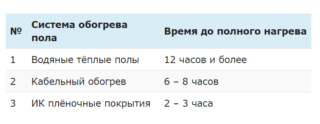
The quality of surface heating depends on the type of system installed and the material laid on it. The water circuit is inert, but retains heat longer due to the energy stored in the pipes and cement screed. Electric heaters heat faster, but cool too soon. The film reaches the set temperature and loses it almost instantly.
The average floor heating time is:
- water circuits - 10-15 minutes;
- email cables - 7-8 minutes;
- mats - 4-5 minutes;
- IR film - less than 1 min.
This consumes approximately the same amount of energy.
Manufacturers Rating
In the ranking of 10 most famous domestic and foreign manufacturers of underfloor heating, the following companies are leaders:
- DEVI.
- Nexans.
- Ensto.
- Hestedt.
- Profi Therm.
- Extherm.
- Fenix
- Woks.
- RATEY.
- Heatluxury.
Products are highly efficient, reliable, safe and have a long service life. All equipment is adapted to the conditions of Russian housing and the parameters of the current entering it.


